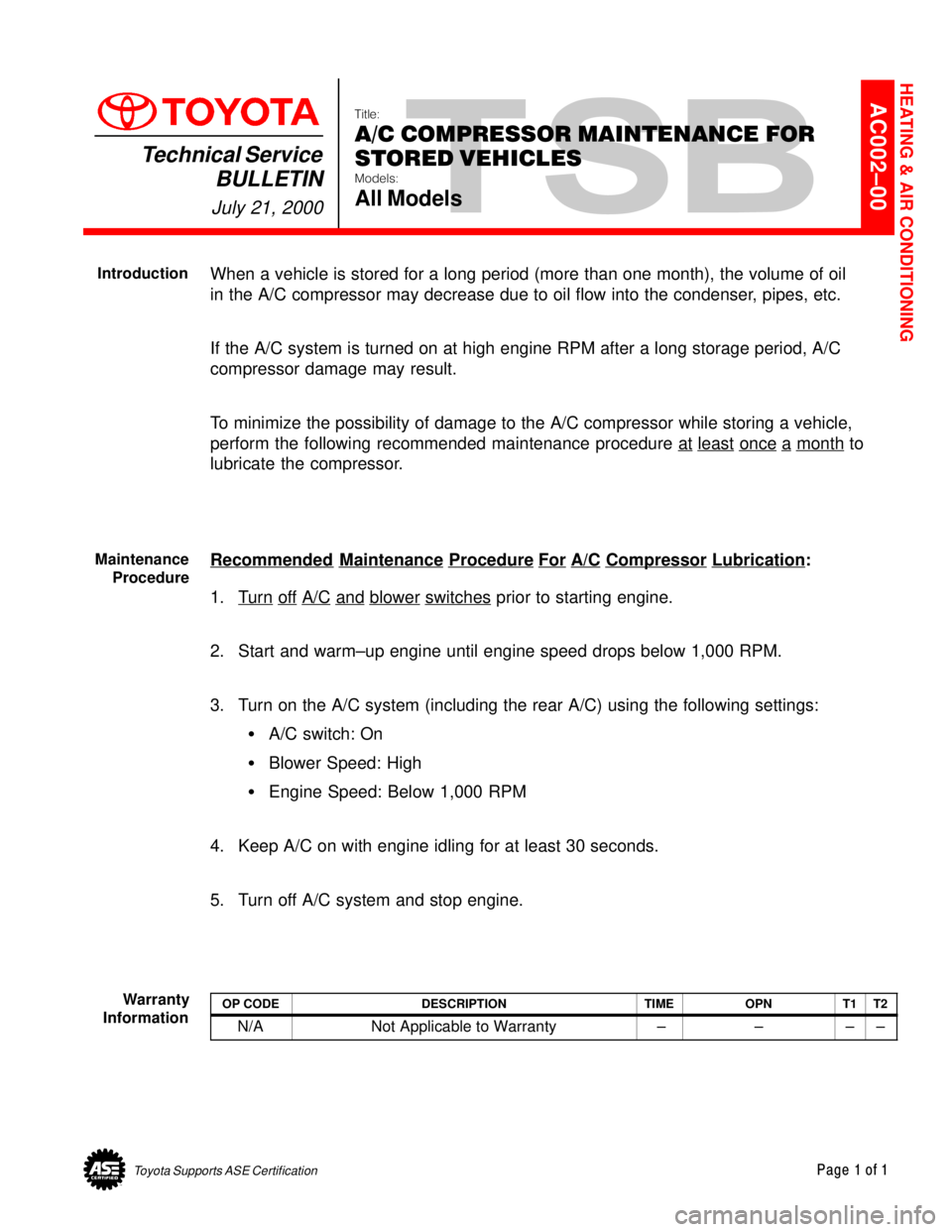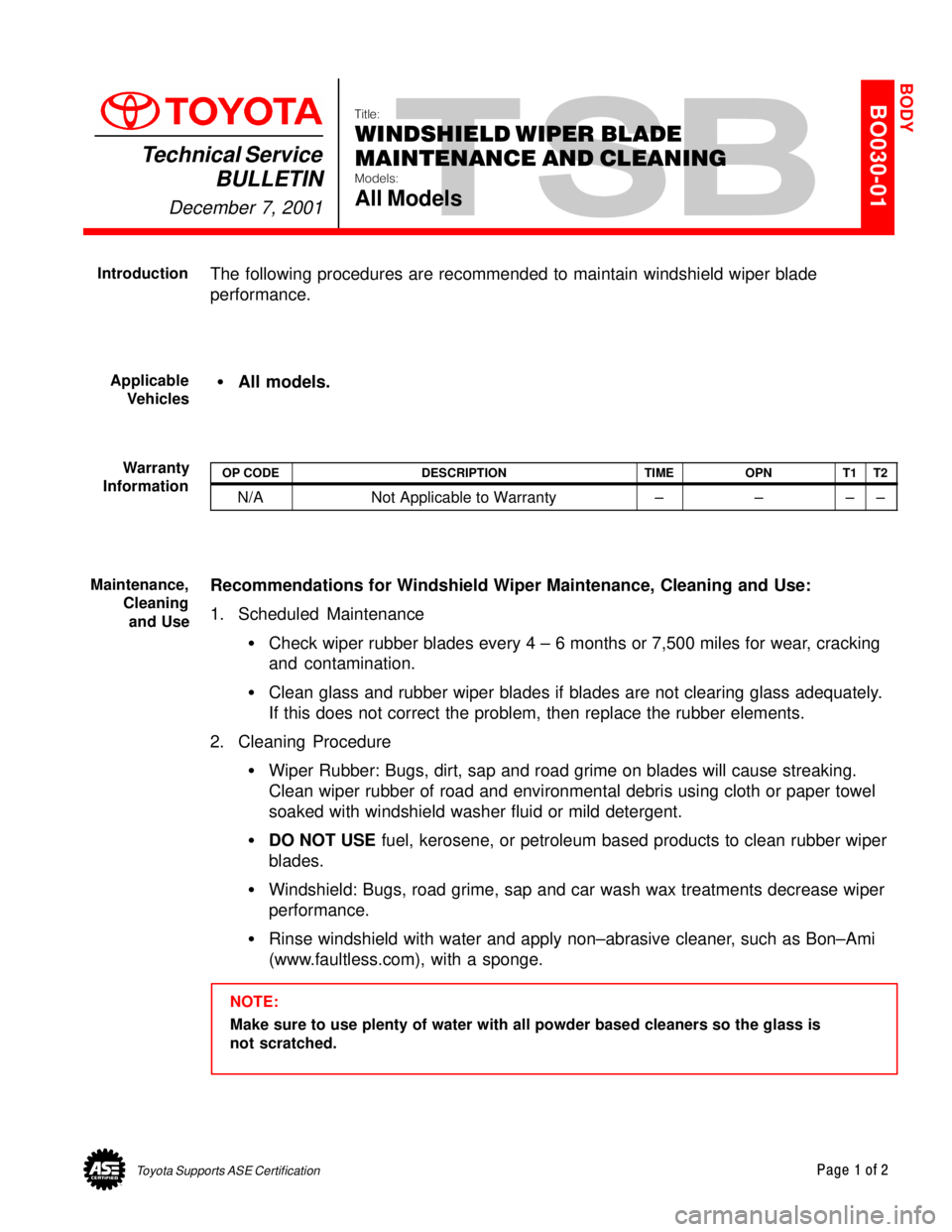Page 3082 of 4592
PP0CE±02
± PREPARATIONCHARGING (1MZ±FE)
PP±57
109 Author�: Date�:
EQUIPMENT
Ammeter(A)
Battery specific gravity gaugeExcept maintenance free battery
Belt tension gauge
Torque wrench
Vernier calipersRotor (Slip ring), Brush
Page 3231 of 4592
SS074±01
SS±4
± SERVICE SPECIFICATIONSMAINTENANCE
167 Author�: Date�:
MAINTENANCE
SERVICE DATA
Front axle and suspension
Ball joint vertical play Maximum
0 mm (0 in.)
Page 3232 of 4592
SS075±01
± SERVICE SPECIFICATIONSMAINTENANCE
SS±5
168 Author�: Date�:
TORQUE SPECIFICATION
Part tightenedN´mkgf´cmft´lbf
Front seat mount bolts3737527
Front suspension member x Body1811,850134
Rear suspension member x Body5152038
Page 3277 of 4592
SS0AQ±01
± SERVICE SPECIFICATIONSCHARGING (5S±FE)
SS±39
202 Author�: Date�:
CHARGING(5S±FE)
SERVICE DATA
BatterySpecific gravity (Except maintenance±free battery)
at 20°C (68°F)
Voltage (Maintenance±free battery) at 20°C (68°F)
1.25 ± 1.29
12.5 ± 12.9 V
Drive beltTension w/ A/C New belt
Used belt
w/o A/C New belt
Used belt165 ± 25 lbf
110 ± 10 lbf
125 ± 25 lbf
95 ± 20 lbf
GeneratorRated output
Rotor coil resistance at 20°C (68°F)
Slip ring diameter STD
Minimum
Brush exposed length STD
Minimum12 V 80 A
2.7 ± 3.1 W
14.2 ± 14.4 mm (0.559 ± 0.567 in.)
12.8 mm (0.504 in.)
10.5 mm (0.413 in.)
1.5 mm (0.059 in.)
Voltage
regulatorRegulating voltage13.5 ± 15.1 V
Page 3323 of 4592

SF0D6±04
± SFI (5S±FE)SFI SYSTEM
SF±1
1434 Author�: Date�:
SFI SYSTEM
PRECAUTION
1. BEFORE WORKING ON FUEL SYSTEM, DISCON-
NECT NEGATIVE (±) TERMINAL CABLE FROM BAT-
TERY
HINT:
Any diagnostic trouble code retained by the computer will be
erased when the negative (±) terminal cable is removed from
the battery.
Therefore, if necessary, read the diagnosis before removing the
negative (±) terminal cable from the battery.
2. DO NOT SMOKE OR WORK NEAR AN OPEN FLAME
WHEN WORKING ON THE FUEL SYSTEM
3. KEEP GASOLINE AWAY FROM RUBBER OR LEATH-
ER PARTS
4. MAINTENANCE PRECAUTIONS
(a) In event of engine misfire, these precautions should be
taken.
(1) Check proper connection to battery terminals, etc.
(2) After repair work, check that the ignition coil termi-
nals and all other ignition system lines are recon-
nected securely.
(3) When cleaning the engine compartment, be espe-
cially careful to protect the electrical system from
water.
(b) Precautions when handling the oxygen sensor.
(1) Do not allow oxygen sensor to drop or hit against an
object.
(2) Do not allow the sensor to come into contact with
water.
5. IF VEHICLE IS EQUIPPED WITH MOBILE RADIO SYS-
TEM (HAM, CB, ETC.)
If the vehicle is equipped with a mobile communication system,
refer to the precaution in the IN section.
6. AIR INDUCTION SYSTEM
(a) Separation of the engine oil dipstick, oil filler cap, PCV
hose, etc. may cause the engine to run out of tune.
(b) Disconnection, looseness or cracks in the parts of the air
induction system between the throttle body and cylinder
head will allow air suction and cause the engine to run out
of tune.
7. ELECTRONIC CONTROL SYSTEM
(a) Before removing SFI wiring connectors, terminals, etc.,
first disconnect the power by either turning the ignition
switch OFF or disconnecting the negative (±) terminal
cable from the battery.
HINT:
Always check the diagnostic trouble code before disconnecting
the negative (±) terminal cable from the battery.
Page 3389 of 4592

SF078±03
± SFI (1MZ±FE)SFI SYSTEM
SF±1
1500 Author�: Date�:
SFI SYSTEM
PRECAUTION
1. BEFORE WORKING ON FUEL SYSTEM,
DISCONNECT NEGATIVE (±) TERMINAL CABLE
FROM BATTERY
HINT:
Any diagnostic trouble code retained by the computer will be
erased when the negative (±) terminal cable is removed from
the battery.
Therefore, if necessary, read the diagnosis before removing the
negative (±) terminal cable from the battery.
2. DO NOT SMOKE OR WORK NEAR AN OPEN FLAME
WHEN WORKING ON FUEL SYSTEM
3. KEEP GASOLINE AWAY FROM RUBBER OR
LEATHER PARTS
4. MAINTENANCE PRECAUTIONS
(a) In event of engine misfire, these precautions should be
taken.
(1) Check proper connection to battery terminals, etc.
(2) After repair work, check that the ignition coil termi-
nals and all other ignition system lines are recon-
nected securely.
(3) When cleaning the engine compartment, be espe-
cially careful to protect the electrical system from
water.
(b) Precautions when handling the oxygen sensor.
(1) Do not allow the oxygen sensor to drop or hit
against an object.
(2) Do not allow the sensor to come into contact with
water.
5. IF VEHICLE IS EQUIPPED WITH A MOBILE RADIO
SYSTEM (HAM, CB, ETC.)
If the vehicle is equipped with a mobile communication system,
refer to the precaution in the IN section.
6. AIR INDUCTION SYSTEM
(a) Separation of the engine oil dipstick, oil filler cap, PCV
hose, etc. may cause the engine to run out of tune.
(b) Disconnection, looseness or cracks in the parts of the air
induction system between the throttle body and cylinder
head will allow air suction and cause the engine to run out
of tune.
7. ELECTRONIC CONTROL SYSTEM
(a) Before removing SFI wiring connectors, terminals, etc.,
first disconnect the power by either turning the ignition
switch to LOCK or disconnecting the negative (±) terminal
cable from the battery.
HINT:
Always check the diagnostic trouble code before disconnecting
the negative (±) terminal cable from the battery.
Page 3654 of 4592

Toyota Supports ASE CertificationPage 1 of 1
AC002±00
Title:
A/C COMPRESSOR MAINTENANCE FOR
STORED VEHICLES
Models:
All Models
Technical Service
BULLETIN
July 21, 2000
When a vehicle is stored for a long period (more than one month), the volume of oil
in the A/C compressor may decrease due to oil flow into the condenser, pipes, etc.
If the A/C system is turned on at high engine RPM after a long storage period, A/C
compressor damage may result.
To minimize the possibility of damage to the A/C compressor while storing a vehicle,
perform the following recommended maintenance procedure at
least once a month to
lubricate the compressor.
Recommended
Maintenance Procedure For A/C Compressor Lubrication:
1. Turn
off A/C and blower switches prior to starting engine.
2. Start and warm±up engine until engine speed drops below 1,000 RPM.
3. Turn on the A/C system (including the rear A/C) using the following settings:
�A/C switch: On
�Blower Speed: High
�Engine Speed: Below 1,000 RPM
4. Keep A/C on with engine idling for at least 30 seconds.
5. Turn off A/C system and stop engine.
OP CODEDESCRIPTIONTIMEOPNT1T2
N/ANot Applicable to Warranty ±±±±
HEATING & AIR CONDITIONING
Introduction
Maintenance
Procedure
Warranty
Information
Page 3751 of 4592

Toyota Supports ASE CertificationPage 1 of 2
BO030-01Title:
WINDSHIELD WIPER BLADE
MAINTENANCE AND CLEANING
Models:
All Models
Technical Service
BULLETIN
December 7, 2001
The following procedures are recommended to maintain windshield wiper blade
performance.
�All models.
OP CODEDESCRIPTIONTIMEOPNT1T2
N/ANot Applicable to Warranty±±±±
Recommendations for Windshield Wiper Maintenance, Cleaning and Use:
1. Scheduled Maintenance
�Check wiper rubber blades every 4 ± 6 months or 7,500 miles for wear, cracking
and contamination.
�Clean glass and rubber wiper blades if blades are not clearing glass adequately.
If this does not correct the problem, then replace the rubber elements.
2. Cleaning Procedure
�Wiper Rubber: Bugs, dirt, sap and road grime on blades will cause streaking.
Clean wiper rubber of road and environmental debris using cloth or paper towel
soaked with windshield washer fluid or mild detergent.
�DO NOT USE fuel, kerosene, or petroleum based products to clean rubber wiper
blades.
�Windshield: Bugs, road grime, sap and car wash wax treatments decrease wiper
performance.
�Rinse windshield with water and apply non±abrasive cleaner, such as Bon±Ami
(www.faultless.com), with a sponge.
NOTE:
Make sure to use plenty of water with all powder based cleaners so the glass is
not scratched.
BODY
Introduction
Applicable
Vehicles
Warranty
Information
Maintenance,
Cleaning
and Use